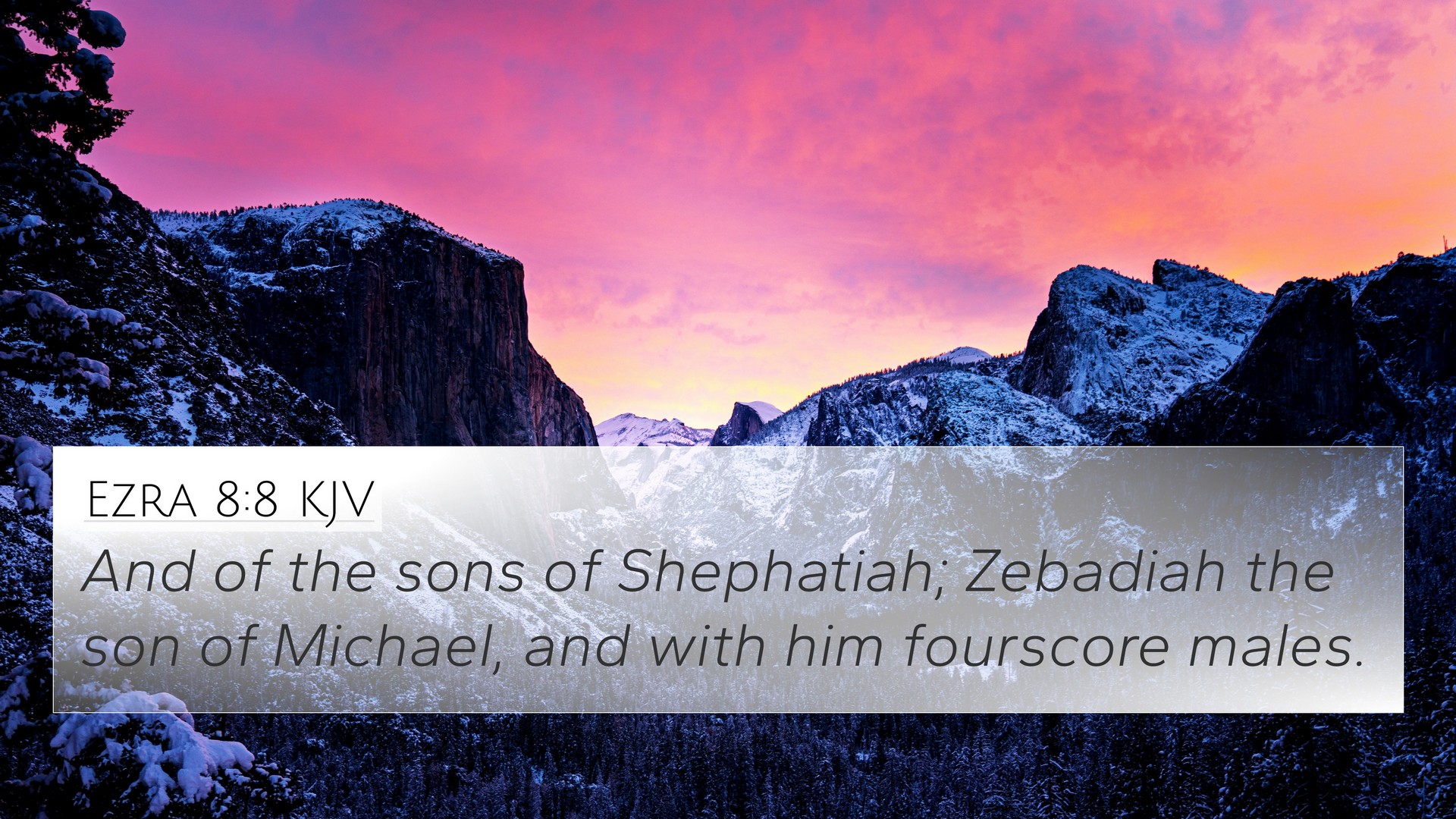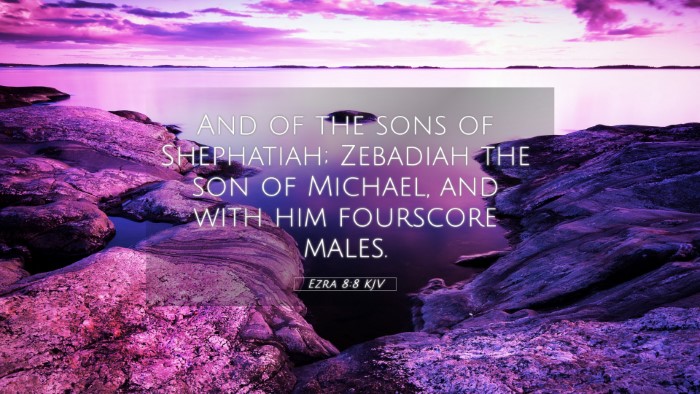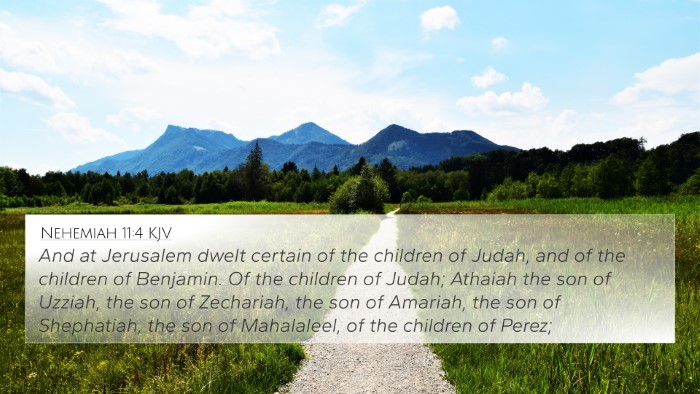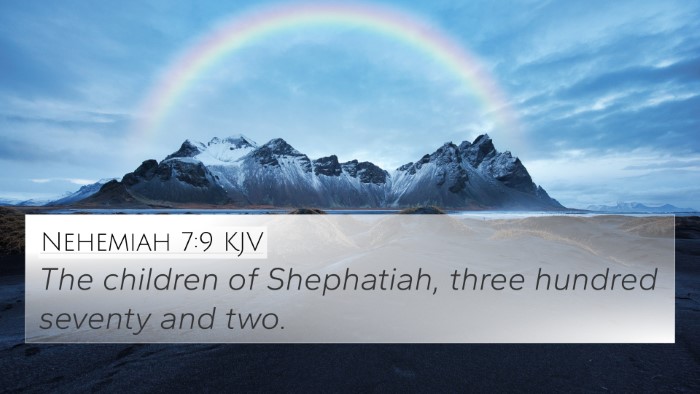Understanding Ezra 8:8
Ezra 8:8 states:
"And of the sons of Abitub, the son of Joshua, the son of Ozaiah, there were three brothers: Eliezer, Izrahiah, and Johanan. And of the sons of Abitub, there were 70 of their kin." (Ezra 8:8)
Meaning and Context
This verse is part of a larger narrative in the book of Ezra, which recounts the return of the Jewish exiles from Babylon to Jerusalem. Ezra, a scribe and priest, led a group back to restore worship and instruction in the Law of God. Each individual's lineage is documented to emphasize the importance of priestly and Levitical lineage in post-exilic Israel.
Commentary Insights
The following insights are drawn from public domain commentaries:
- Matthew Henry: Highlights that Ezra’s genealogical records serve to validate the legitimacy of those returning to Jerusalem. Such listings often reflect the faithfulness of God in preserving His people throughout captivity.
- Albert Barnes: Notes the significance of familial lines, stressing that the re-establishment of the community included a recognition of heritage, demonstrating God's continued covenant with Israel.
- Adam Clarke: Points out that Ezra’s meticulous attention to detail in genealogy reflects his commitment to ensuring that all worship practices in the temple are aligned with God's commandments. The verse illustrates the order and structure needed in worship.
Keywords and Connections
This verse presents an opportunity for cross-referencing with various biblical themes and scriptures. Here are important connections:
- Bible verse cross-references: 1 Chronicles 6:4-15 details the lineage of the Levites, showing the connection to Ezra's priestly heritage.
- Connections between Bible verses: Nehemiah 12:1-13 also discusses the Levitical priests returning to Jerusalem.
- Linking Bible scriptures: Exodus 6:23 outlines the genealogical line of priests.
- Comparative Bible verse analysis: Matthew 1:12 provides a genealogy of Jesus, linking the significance of lineage from different perspectives.
- Bible verses that relate to each other: Hebrews 7:14 discusses Jesus’ descent from the tribe of Judah, contrasting with the Levitical priesthood.
- Cross-referencing Biblical texts: Ezra 2:27 discusses the sons of Abitub, reinforcing the importance of these names in returning exiles.
- Thematic Bible verse connections: Isaiah 2:3 speaks of the importance of teaching God's law, resonating with Ezra’s mission.
- Bible verse parallels: Jeremiah 29:10-14 reflects the hope of returning to the promised land, setting the stage for Ezra’s journey.
- Scriptural cross-referencing: John 3:5 shows the theme of spiritual rebirth, drawing parallels between the physical return to Jerusalem and spiritual renewal.
- Inter-Biblical dialogue: Acts 7:2-53 references historical accounts from the Old Testament, establishing a dialogue between the Old and New Covenants.
Tools for Bible Cross-Referencing
To dive deeper into the connections and thematic relationships of this passage, consider the following tools:
- Bible concordance: A helpful resource for finding topics and verses.
- Bible cross-reference guide: Utilize these guides for thematic studies.
- Cross-reference Bible study: Engage in studying passages that relate to one another.
- How to use Bible cross-references: Apply these techniques for a deeper understanding of scripture.
- Bible reference resources: Build a library of reliable cross-reference materials.
- Bible chain references: Create a network of connected verses.
- Comprehensive Bible cross-reference materials: Consider online databases and study aids.
Long-Tail Keywords and Study Tips
For those seeking further understanding, here are some long-tail keywords and tips:
- How to find cross-references in the Bible: Advocate for using concordances and study Bibles.
- Identifying connections between Old and New Testament: Compare themes of redemption and lineage.
- Detailed cross-reference between Gospels: Investigate how genealogies in the Gospels relate to Old Testament texts.
- Look for Bible verses related to specific themes: Consolidate research on key topics highlighted in scripture.
- Cross-referenced themes in the Bible: Explore overarching themes like hope, redemption, and covenant.
- Comparative study of Pauline epistles: Note the differing focuses Paul has on law, freedom, and heritage.
- Links between the Prophets and Apostolic teachings: Study how prophetic promises are fulfilled in New Testament writings.
- Cross-referencing Psalms with New Testament teachings: Recognize how Jesus and apostles link to Psalms.
- Bible cross-references for sermon preparation: Use them to build a robust theological frame.
- Interpreting Biblical themes through cross-references: Analyze how recurring themes shape interpretation and understanding.





